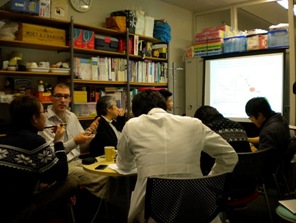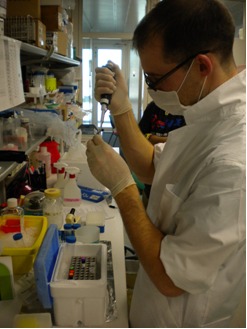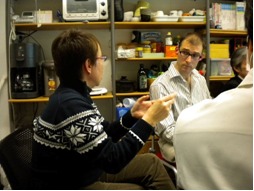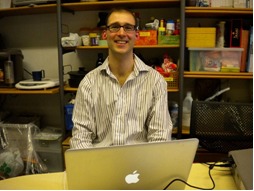Young Researchers' Trip report
- 2012年度
- 2011年度
- 2010年度
- Keystone Symposia -Mechanism and Biology of Silencing-
(2011年3月20日~2011年3月25日) - Keystone Symposia (Stem cells, cancer and metastasis)
(2011年3月6日~2011年3月11日) - Keystone Symposia (Stem cells, cancer and metastasis)
(2011年3月6日~2011年3月11日) - 第7回日本消化管学会総会学術集会
(2011年2月18日~2011年2月19日) - 短期留学生(研修)受け入れ University of Birmingham, UK → 生理学
(2011年1月22日~2011年2月12日) - 第6回オートファジー研究会
(2011年1月12日~2011年1月14日) - 33rd Annual San Antonio Breast Cancer Symposium
(2010年12月6日~2010年12月10日) - 52nd ASH(American Society of Hematology) Annual Meeting
(2010年12月3日~2010年12月8日)
- Keystone Symposia -Mechanism and Biology of Silencing-
ホーム > Young Researchers' Trip report > 短期留学生(研修)受け入れ University of Birmingham, UK → 生理学
短期留学生(研修)受け入れ University of Birmingham, UK → 生理学
氏名
Dr. Diarmaid Houlihan
所属
Centre for liver Research, Institute of Biomedical Research, University of Birmingham, UK
→ 生理学 (松崎ラボ)/ GCOE FCM(フローサイトメトリー教育研究センター)
滞在期間
2011年1月22日~2011年2月12日
活動レポート
Dr. Diarmaid Houlihanは、バーミンガム大学の彼の研究室ではまだ成功していない技術(間葉系幹細胞の分離手法)を生理学教室(幹細胞グループ)で学ぶために来日しました。
この最新技術を学ぶことにより、イギリスでの自らが行う研究にすばらしい成果をもたらすと共に、彼の所属する研究室にとっても 大きなメリットとなることが期待されます。
海外の研究機関との比較や、国際交流を図ることにより、受け入れ研究室の者の志気も上がり良い刺激となりました。また、国外からの研究者をGlobal COE Young Researcher support Planで支援することより、今後の研究室およびグローバルCOEの国際化が拡大されるというメリットも期待できます。
日本滞在についての感想等をいただきましたのでご紹介します。
How did you like your stay:
This was my first visit to Japan. My most impressive memory from my visit to Tokyo is the exceptionally warm welcome that I received from Prof Matsuzaki and all the laboratory staff. I was made feel at home in the laboratory. I was included all laboratory activities. Despite not being able to speak Japanese, I never felt that language was a barrier to communication. I was invited and went out for dinner in the evenings and even got to the cinema to see 'The Social Network' as part of a laboratory outing. I feel very fortunate that I have been given the opportunity to visit Prof Matsuzaki's laboratory and have made many friends in the short time I was there. I look forward to the day when I can welcome staff members to the UK and return some of the kindness that was shown to me.
During my stay I managed to soak up many of the sights and sounds in Tokyo. Among the many places I visited, I was particularly impressed with the Temples in Asakusa, the shopping in Harajuku and Shibuya and the buzz and excitement of Shinkuku. I also amazed by the Imperial Gardens, the fish markets and the shops in Ginza. During my spare time I also managed to leave Tokyo and make enjoyable trips to Lake Kawaguchi and Yokohama. Tokyo is an amazing place and I hope to return some day.

What you learned:
I am a clinical research fellow investigating the potential therapeutic benefit of mesenchymal stem cells (MSCs) in liver disease.
The isolation of a pure population of murine MSCs has been very difficult until recently. Traditional methods of MSC isolation rely on the adherent properties of these cells to plastic. This methodology yields a heterogenous population admixed with fibroblasts, macrophages and haematopoietic cells. This has made the use of MSCs as a research tool and therapeutic intervention difficult.
In a landmark paper published just over a year ago, Professor Matsuzaki reported the prospective isolation of murine MSCs based on Sca-1 and PDGFR receptor expression. These cells are very rare (0.05% of bone marrow) and are capable of robust multi-lineage differentiation and have potent replicative capacity. This paper represents a significant advancement for the field and the validity of future experiments and projects (including my thesis) using Sca-1+PDGFR + MSCs will be far more robust.
Over the past 6 months I have spent a significant amount of time trying to establish this technique in the University of Birmingham. I have been in contact with Professor Matsuzaki and she has been very supportive and has emphasized the difficulty of some of the steps. Recently, Professor Matsuzaki invited me to visit her laboratory in Japan and I accepted this offer.
My visit to Professor Matsuzaki's laboratory has been extremely beneficial. I was taken through the isolation of Sca-1+PDGFR + in a stepwise fashion. Firstly, I observed her senior researchers Yo Mabuchi and Daisuke Araki ( to whom I am very grateful) carry out each step in the isolation. They took time to explain the importance and subtly of each step in the process. I subsequently carried out the isolation on numberous occasions and finally when my mentors were confident that I had mastered the steps involved, I was asked to teach another visiting student the isolation technique. Since returning to the UK I have successfully isolated Sca-1+ PDGRF+ cells and am extremely grateful for the excellent teaching I received from Yo and Daisuke.
Working with Sca-1+/PDGFR + MSCs will be of huge benefit to me. Working with this cell type will provide me with the unique opportunity to examine the effects of MSCs in liver injury and tease out potential immunosuppressive effects that these cells have.

*Things you found interesting in our lab (Comparison to your lab and any differences that surprised you)
The working relationship between the staff members was very good. There was always a friendly feel to the laboratory. I was extremely impressed by the work ethic among the laboratory staff and this is reflected by the high quality publications currently being produced by the laboratory. Professor Matsuzaki has established a close communication network through facebook. This is used to circulate relevant high impact publications and to facilitate and encourage scientific debate.

*Your impression of Japan
Overall, I was extremely impressed by Japan. The incredible kindness shown to me by Professor Matsuzaki and her staff has left a lasting impression on me. Tokyo is an incredible city. I look forward to staying in touch with my new friends and hope to visit Tokyo again soon.

Dear Dr. Diarmaid Houlihan
原稿をお寄せいただきありがとうございました。今後のご活躍をお祈りします。
Copyright © Keio University. All rights reserved.
